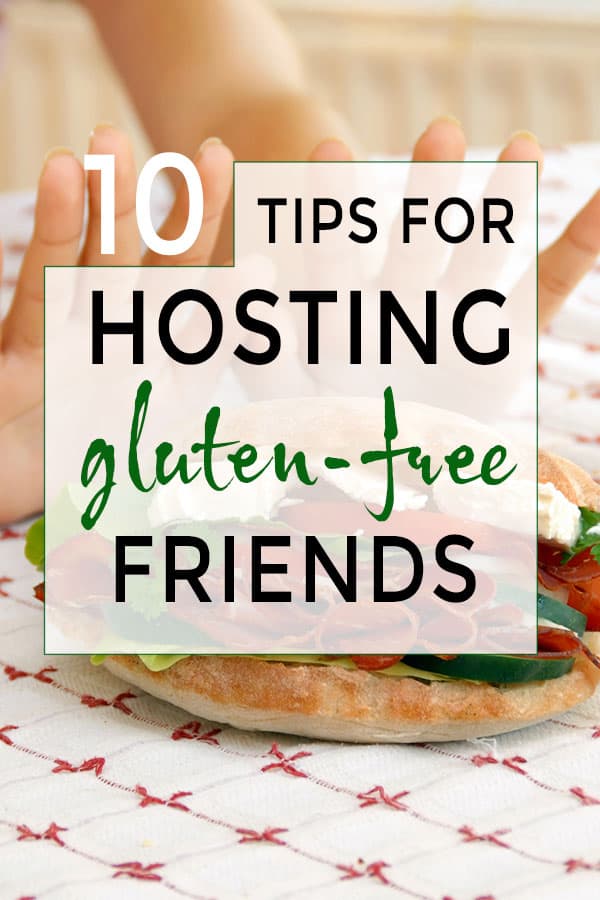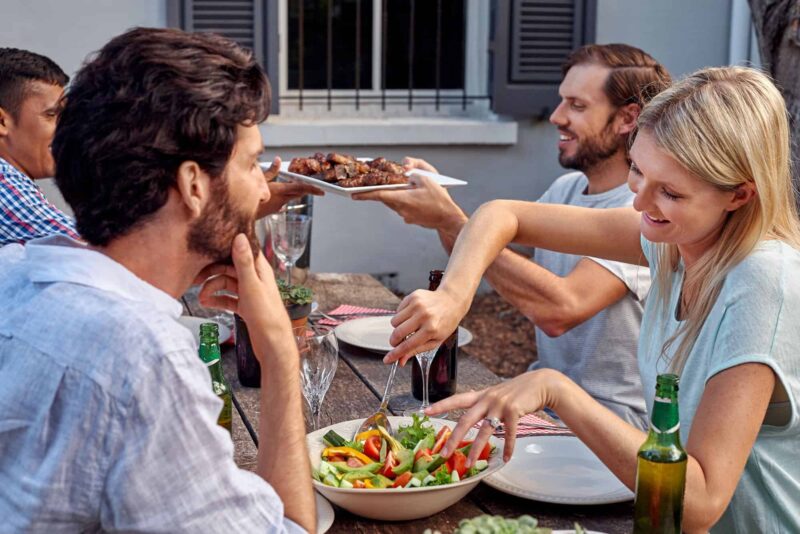
This is a guest post from my good blogger friend Jenny Finke, who writes at Good For You Gluten Free. Jenny writes about how to live a happy, healthy, and fulfilled life with celiac disease or gluten sensitivities or gluten intolerance. I invited her to write about her gluten-free experience and offer some tips on hosting gluten-free friends for people like me who, well, love gluten.
I was diagnosed with celiac disease in April 2012. I learned that the only way to manage and treat the disease is via a strict gluten-free diet.
A celiac disease diagnosis changes your life. We eat, cook and think about food all the time. Having to worry about even a crumb of gluten crossing my lips in order to successfully manage my disease is a challenge few people understand and even fewer will ever have to experience.
Gluten is a protein found in wheat, rye, barley and spelt and can literally damage the lining of the small intestine in people with celiac disease. People with a gluten sensitivity or intolerance also can have a severe inflammatory reaction when eating gluten, so you cannot be complacent just because someone doesn’t have celiac disease. Remember, the vast majority of people avoiding gluten are doing it for health reasons.
Nick teaches you how to cook so many delicious meals for your family and friends and so many of his recipes are gluten-free (check out the Quinoa Spring Rolls – OMG!). But if you’re going to cook for your gluten-free friend, there’s more than just a winning recipe at stake… there’s a winning process you must follow, too.
Creating a delicious – and safe – meal for your gluten-free friend requires a lot of thought, consideration and communication. You don’t want your friend getting sick because you didn’t take the proper precautions, do you?
To avoid any snafus in the kitchen while preparing any of my gluten-free dishes, please read through these tips first.
Tips to Hosting Your Gluten-Free Friend for Dinner
1. Consult on the Menu: Have an upfront and honest conversation with your friend about your menu. Let her know what you’d like to make and ask her what precautions or swaps you should make to your menu or ingredient list to make it safe for her to eat. You also can ask her for ideas on what she likes to eat and what dishes are commonly prepared gluten-free. A lot of people don’t realize that rice, corn, and potatoes are naturally gluten-free!
2. Check ALL Ingredient Labels: Hidden gluten is everywhere – in your spices, tea bags, chicken broth, BBQ sauce and soy sauce. Gluten is not just inside things that look like bread or pasta. Read labels, look for gluten-free disclosures on food labels, and when it doubt, don’t use it.
3. Make It All GF: Life will be easier for everyone if you make the entire meal gluten-free. If you must make something with gluten in it as part of the meal, make sure your friend takes her food first before everyone touches the food and spreads gluten everywhere. A good example of this is when you’re serving a burger bar. Your friend can easily enjoy a burger (without bun), but if there are buns on the table, the burgers often come in contact with the buns when everyone is going through the buffet line.
4. Keep It Naturally Gluten-Free: Naturally gluten-free foods are easy to make and don’t cost a lot of money. Baked chicken, steamed vegetables and potatoes are all gluten-free, naturally. These Mojito Fruit Kabobs make a great appetizer, this Habanero Apple BBQ Chicken makes a great main dish, these Roasted Garlic Mashed Potatoes make a great side dish, and for dessert, try these Fruit Confetti Popsicles.
5. Ask Your Friend to Help: Enlist your friend to help make a dish (or two) that you might feel uncomfortable making yourself. I’m almost always asked to bring a dessert, which I’m happy to do! Your gluten-free friend might even offer to make a couple of dishes just to help lighten the load. Accept any and all offers on the table.
6. Beware of the Grill: If you’ve ever cooked gluten on your grill – like a soy sauce or teriyaki marinated meat, or toasted buns – than your grill is not safe to use for your GF friend. You can cook your friend’s burger in the oven, a clean pan, or wrapped in tinfoil on the grill.
7. Avoid Appliances that Touch Gluten: Along the same lines as the grill, avoid using your toaster, strainer and electric mixers when preparing a meal for your gluten-free friend. All of these appliances have touched gluten and aren’t cleaned thoroughly enough to be safe for your friend.
8. Use Clean Hands. Always use clean hands when preparing gluten-free food. If you touch bread, then touch the salad, you might be dripping bread crumbs into something your friend could have safely enjoyed.
9. Follow Up: Once your friend arrives at your party, take the time to put her at ease by walking her through the menu. Do this privately as to not single out your friend in front of everyone. At this time, you’ll be able to offer her extra assurance and confidence in the night’s meal – and she will appreciate the thought and careful preparation that went into hosting her.
10. Have Fun: While it might seem stressful, at least at first, to host your gluten-free friend for dinner, you’ll probably be surprised at the end of the day just how easy it is to create a totally delicious AND gluten-free dinner. And you’ll get major friendship points for putting forth the extra effort to host your friend. Unfortunately, us GF folk often get left out of the fun.
Thanks for the tips Jenny! Be sure to follow Jenny on Instagram for delicious Gluten-free recipes!



Cynetta
Often things we don’t think about as ingredients may contain gluten. Example – we’re mostly aware that soy sauce contains wheat and therefore gluten plus the warn you on the label
The picture at the top of this article shows beverage bottles that likely beer. Few ever think that most beer is made with barley and barley contains gluten. Up until this past springwhen reading a recipe by a person with celiac disease, I never thought about regular beer containing gluten and I frequently use beer as an ingredient in some of my cooking.
Unlike cans or bottles of food, there are no lists of ingredients or food allergy warnings on a beer label
Michelle
I was diagnosed with Celiac a year ago and all of this is fantastic advice. I would say the accidental cross-contamination of gluten from one dish to another is the thing I worry about most. People don’t realize that if they use the spoon for mac salad and then plop it into a gluten-free dish, that dish is no longer gluten free. :( And of course, who would think of this if you don’t have Celiac? It’s an otherwise totally normal thing to do. So I love Jenny’s suggestion to only serve GF items if possible – that reduces the possibility of this happening!